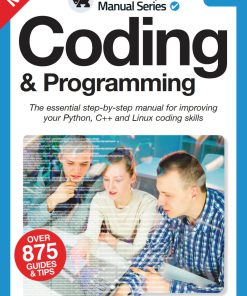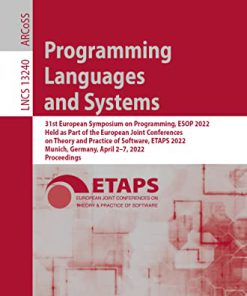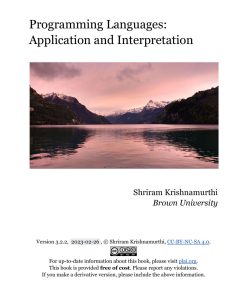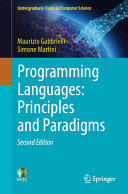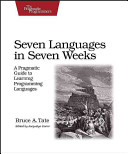Concepts of Programming Languages 12th Edition by Robert W Sebesta ISBN 9780134997186 0134997182
$50.00 Original price was: $50.00.$25.00Current price is: $25.00.
Concepts of Programming Languages 12th Edition by Robert W Sebesta – Ebook PDF Instant Download/Delivery: 9780134997186 ,0134997182
Full download Concepts of Programming Languages 12th Edition after payment

Product details:
ISBN 10: 0134997182
ISBN 13: 9780134997186
Author: Robert W Sebesta
Concepts of Programming Languages 12th Edition Table of contents:
1 Preliminaries
1.1 Reasons for Studying Concepts of Programming Languages
1.2 Programming Domains
1.2.1 Scientific Applications
1.2.2 Business Applications
1.2.3 Artificial Intelligence
1.2.4 Web Software
1.3 Language Evaluation Criteria
1.3.1 Readability
1.3.1.1 Overall Simplicity
1.3.1.2 Orthogonality
1.3.1.3 Data Types
1.3.1.4 Syntax Design
1.3.2 Writability
1.3.2.1 Simplicity and Orthogonality
1.3.2.2 Expressivity
1.3.3 Reliability
1.3.3.1 Type Checking
1.3.3.2 Exception Handling
1.3.3.3 Aliasing
1.3.3.4 Readability and Writability
1.3.4 Cost
1.4 Influences on Language Design
1.4.1 Computer Architecture
1.4.2 Programming Design Methodologies
1.5 Language Categories
1.6 Language Design Trade-Offs
1.7 Implementation Methods
1.7.1 Compilation
1.7.2 Pure Interpretation
1.7.3 Hybrid Implementation Systems
1.7.4 Preprocessors
1.8 Programming Environments
SUMMARY
REVIEW QUESTIONS
PROBLEM SET
2 Evolution of the Major Programming Languages
2.1 Zuse’s Plankalkül
2.1.1 Historical Background
2.1.2 Language Overview
2.2 Pseudocodes
2.2.1 Short Code
2.2.2 Speedcoding
2.2.3 The UNIVAC “Compiling” System
2.2.4 Related Work
2.3 The IBM 704 and Fortran
2.3.1 Historical Background
2.3.2 Design Process
2.3.3 Fortran I Overview
2.3.4 Fortran II
2.3.5 Fortrans IV, 77, 90, 95, 2003, and 2008
2.3.6 Evaluation
2.4 Functional Programming: Lisp
2.4.1 The Beginnings of Artificial Intelligence (AI) and List Processing
2.4.2 Lisp Design Process
2.4.3 Language Overview
2.4.3.1 Data Structures
2.4.3.2 Processes in Functional Programming
2.4.3.3 The Syntax of Lisp
2.4.4 Evaluation
2.4.5 Two Descendants of Lisp
2.4.5.1 Scheme
2.4.5.2 Common Lisp
2.4.6 Related Languages
2.5 The First Step Toward Sophistication: ALGOL 60
2.5.1 Historical Background
2.5.2 Early Design Process
2.5.3 ALGOL 58 Overview
2.5.4 Reception of the ALGOL 58 Report
2.5.5 ALGOL 60 Design Process
2.5.6 ALGOL 60 Overview
2.5.7 Evaluation
2.6 Computerizing Business Records: COBOL
2.6.1 Historical Background
2.6.2 FLOW-MATIC
2.6.3 COBOL Design Process
2.6.4 Evaluation
2.7 The Beginnings of Timesharing: Basic
2.7.1 Design Process
2.7.2 Language Overview
2.7.3 Evaluation
2.8 Everything for Everybody: PL/I
2.8.1 Historical Background
2.8.2 Design Process
2.8.3 Language Overview
2.8.4 Evaluation
2.9 Two Early Dynamic Languages: APL and SNOBOL
2.9.1 Origins and Characteristics of APL
2.9.2 Origins and Characteristics of SNOBOL
2.10 The Beginnings of Data Abstraction: SIMULA 67
2.10.1 Design Process
2.10.2 Language Overview
2.11 Orthogonal Design: ALGOL 68
2.11.1 Design Process
2.11.2 Language Overview
2.11.3 Evaluation
2.12 Some Early Descendants of the ALGOLs
2.12.1 Simplicity by Design: Pascal
2.12.1.1 Historical Background
2.12.1.2 Evaluation
2.12.2 A Portable Systems Language: C
2.12.2.1 Historical Background
2.12.2.2 Evaluation
2.13 Programming Based on Logic: Prolog
2.13.1 Design Process
2.13.2 Language Overview
2.13.3 Evaluation
2.14 History’s Largest Design Effort: Ada
2.14.1 Historical Background
2.14.2 Design Process
2.14.3 Language Overview
2.14.4 Evaluation
2.14.5 Ada 95 and Ada 2005
2.15 Object-Oriented Programming: Smalltalk
2.15.1 Design Process
2.15.2 Language Overview
2.15.3 Evaluation
2.16 Combining Imperative and Object-Oriented Features: C++
2.16.1 Design Process
2.16.2 Language Overview
2.16.3 Evaluation
2.16.4 A Replacement for Objective-C, Swift
2.16.5 Another Related Language: Delphi
2.17 An Imperative-Based Object-Oriented Language: Java
2.17.1 Design Process
2.17.2 Language Overview
2.17.3 Evaluation
2.18 Scripting Languages
2.18.1 Origins and Characteristics of Perl
2.18.2 Origins and Characteristics of JavaScript
2.18.3 Origins and Characteristics of PHP
2.18.4 Origins and Characteristics of Python
2.18.5 Origins and Characteristics of Ruby
2.19 The Flagship .NET Language: C#
2.19.1 Design Process
2.19.2 Language Overview
2.19.3 Evaluation
2.20 Markup-Programming Hybrid Languages
2.20.1 XSLT
2.20.2 JSP
SUMMARY
BIBLIOGRAPHIC NOTES
REVIEW QUESTIONS
PROBLEM SET
PROGRAMMING EXERCISES
3 Describing Syntax and Semantics
3.1 Introduction
3.2 The General Problem of Describing Syntax
3.2.1 Language Recognizers
3.2.2 Language Generators
3.3 Formal Methods of Describing Syntax
3.3.1 Backus-Naur Form and Context-Free Grammars
3.3.1.1 Context-Free Grammars
3.3.1.2 Origins of Backus-Naur Form
3.3.1.3 Fundamentals
3.3.1.4 Describing Lists
3.3.1.5 Grammars and Derivations
3.3.1.6 Parse Trees
3.3.1.7 Ambiguity
3.3.1.8 Operator Precedence
3.3.1.9 Associativity of Operators
3.3.1.10 An Unambiguous Grammar for if-else
3.3.2 Extended BNF
3.3.3 Grammars and Recognizers
3.4 Attribute Grammars
3.4.1 Static Semantics
3.4.2 Basic Concepts
3.4.3 Attribute Grammars Defined
3.4.4 Intrinsic Attributes
3.4.5 Examples of Attribute Grammars
3.4.6 Computing Attribute Values
3.4.7 Evaluation
3.5 Describing the Meanings of Programs: Dynamic Semantics
3.5.1 Operational Semantics
3.5.1.1 The Basic Process
3.5.1.2 Evaluation
3.5.2 Denotational Semantics
3.5.2.1 Two Simple Examples
3.5.2.2 The State of a Program
3.5.2.3 Expressions
3.5.2.4 Assignment Statements
3.5.2.5 Logical Pretest Loops
3.5.2.6 Evaluation
3.5.3 Axiomatic Semantics
3.5.3.1 Assertions
3.5.3.2 Weakest Preconditions
3.5.3.3 Assignment Statements
3.5.3.4 Sequences
3.5.3.5 Selection
3.5.3.6 Logical Pretest Loops
3.5.3.7 Program Proofs
3.5.3.8 Evaluation
SUMMARY
BIBLIOGRAPHIC NOTES
REVIEW QUESTIONS
PROBLEM SET
4 Lexical and Syntax Analysis
4.1 Introduction
4.2 Lexical Analysis
4.3 The Parsing Problem
4.3.1 Introduction to Parsing
4.3.2 Top-Down Parsers
4.3.3 Bottom-Up Parsers
4.3.4 The Complexity of Parsing
4.4 Recursive-Descent Parsing
4.4.1 The Recursive-Descent Parsing Process
4.4.2 The LL Grammar Class
4.5 Bottom-Up Parsing
4.5.1 The Parsing Problem for Bottom-Up Parsers
4.5.2 Shift-Reduce Algorithms
4.5.3 LR Parsers
SUMMARY
REVIEW QUESTIONS
PROBLEM SET
PROGRAMMING EXERCISES
5 Names, Bindings, and Scopes
5.1 Introduction
5.2 Names
5.2.1 Design Issues
5.2.2 Name Forms
5.2.3 Special Words
5.3 Variables
5.3.1 Name
5.3.2 Address
5.3.3 Type
5.3.4 Value
5.4 The Concept of Binding
5.4.1 Binding of Attributes to Variables
5.4.2 Type Bindings
5.4.2.1 Static Type Binding
5.4.2.2 Dynamic Type Binding
5.4.3 Storage Bindings and Lifetime
5.4.3.1 Static Variables
5.4.3.2 Stack-Dynamic Variables
5.4.3.3 Explicit Heap-Dynamic Variables
5.4.3.4 Implicit Heap-Dynamic Variables
5.5 Scope
5.5.1 Static Scope
5.5.2 Blocks
5.5.3 Declaration Order
5.5.4 Global Scope
5.5.5 Evaluation of Static Scoping
5.5.6 Dynamic Scope
5.5.7 Evaluation of Dynamic Scoping
5.6 Scope and Lifetime
5.7 Referencing Environments
5.8 Named Constants
SUMMARY
REVIEW QUESTIONS
PROBLEM SET
PROGRAMMING EXERCISES
6 Data Types
6.1 Introduction
6.2 Primitive Data Types
6.2.1 Numeric Types
6.2.1.1 Integer
6.2.1.2 Floating-Point
6.2.1.3 Complex
6.2.1.4 Decimal
6.2.2 Boolean Types
6.2.3 Character Types
6.3 Character String Types
6.3.1 Design Issues
6.3.2 Strings and Their Operations
6.3.3 String Length Options
6.3.4 Evaluation
6.3.5 Implementation of Character String Types
6.4 Enumeration Types
6.4.1 Design Issues
6.4.2 Designs
6.4.3 Evaluation
6.5 Array Types
6.5.1 Design Issues
6.5.2 Arrays and Indices
6.5.3 Subscript Bindings and Array Categories
6.5.4 Array Initialization
6.5.5 Array Operations
6.5.6 Rectangular and Jagged Arrays
6.5.7 Slices
6.5.8 Evaluation
6.5.9 Implementation of Array Types
6.6 Associative Arrays
6.6.1 Structure and Operations
6.6.2 Implementing Associative Arrays
6.7 Record Types
6.7.1 Definitions of Records
6.7.2 References to Record Fields
6.7.3 Evaluation
6.7.4 Implementation of Record Types
6.8 Tuple Types
6.9 List Types
6.10 Union Types
6.10.1 Design Issues
6.10.2 Discriminated Versus Free Unions
6.10.3 Unions in F#
6.10.4 Evaluation
6.10.5 Implementation of Union Types
6.11 Pointer and Reference Types
6.11.1 Design Issues
6.11.2 Pointer Operations
6.11.3 Pointer Problems
6.11.3.1 Dangling Pointers
6.11.3.2 Lost Heap-Dynamic Variables
6.11.4 Pointers in C and C++
6.11.5 Reference Types
6.11.6 Evaluation
6.11.7 Implementation of Pointer and Reference Types
6.11.7.1 Representations of Pointers and References
6.11.7.2 Solutions to the Dangling-Pointer Problem
6.11.7.3 Heap Management
Single-Size Cells
Variable-Size Cells
6.12 Optional Types
6.13 Type Checking
6.14 Strong Typing
6.15 Type Equivalence
6.16 Theory and Data Types
SUMMARY
BIBLIOGRAPHIC NOTES
REVIEW QUESTIONS
PROBLEM SET
PROGRAMMING EXERCISES
7 Expressions and Assignment Statements
7.1 Introduction
7.2 Arithmetic Expressions
7.2.1 Operator Evaluation Order
7.2.1.1 Precedence
7.2.1.2 Associativity
7.2.1.3 Parentheses
7.2.1.4 Ruby Expressions
7.2.1.5 Expressions in Lisp
7.2.1.6 Conditional Expressions
7.2.2 Operand Evaluation Order
7.2.2.1 Side Effects
7.2.2.2 Referential Transparency and Side Effects
7.3 Overloaded Operators
7.4 Type Conversions
7.4.1 Coercion in Expressions
7.4.2 Explicit Type Conversion
7.4.3 Errors in Expressions
7.5 Relational and Boolean Expressions
7.5.1 Relational Expressions
7.5.2 Boolean Expressions
7.6 Short-Circuit Evaluation
7.7 Assignment Statements
7.7.1 Simple Assignments
7.7.2 Conditional Targets
7.7.3 Compound Assignment Operators
7.7.4 Unary Assignment Operators
7.7.5 Assignment as an Expression
7.7.6 Multiple Assignments
7.7.7 Assignment in Functional Programming Languages
7.8 Mixed-Mode Assignment
SUMMARY
REVIEW QUESTIONS
PROBLEM SET
PROGRAMMING EXERCISES
8 Statement-Level Control Structures
8.1 Introduction
8.2 Selection Statements
8.2.1 Two-Way Selection Statements
8.2.1.1 Design Issues
8.2.1.2 The Control Expression
8.2.1.3 Clause Form
8.2.1.4 Nesting Selectors
8.2.1.5 Selector Expressions
8.2.2 Multiple-Selection Statements
8.2.2.1 Design Issues
8.2.2.2 Examples of Multiple Selectors
8.2.2.3 Implementing Multiple Selection Structures
8.2.2.4 Multiple Selection Using if
8.3 Iterative Statements
8.3.1 Counter-Controlled Loops
8.3.1.1 Design Issues
8.3.1.2 The for Statement of the C-Based Languages
8.3.1.3 The for Statement of Python
8.3.1.4 Counter-Controlled Loops in Functional Languages
8.3.2 Logically Controlled Loops
8.3.2.1 Design Issues
8.3.2.2 Examples
8.3.3 User-Located Loop Control Mechanisms
8.3.4 Iteration Based on Data Structures
8.4 Unconditional Branching
8.5 Guarded Commands
8.6 Conclusions
SUMMARY
REVIEW QUESTIONS
PROBLEM SET
PROGRAMMING EXERCISES
9 Subprograms
9.1 Introduction
9.2 Fundamentals of Subprograms
9.2.1 General Subprogram Characteristics
9.2.2 Basic Definitions
9.2.3 Parameters
9.2.4 Procedures and Functions
9.3 Design Issues for Subprograms
9.4 Local Referencing Environments
9.4.1 Local Variables
9.4.2 Nested Subprograms
9.5 Parameter-Passing Methods
9.5.1 Semantics Models of Parameter Passing
9.5.2 Implementation Models of Parameter Passing
9.5.2.1 Pass-by-Value
9.5.2.2 Pass-by-Result
9.5.2.3 Pass-by-Value-Result
9.5.2.4 Pass-by-Reference
9.5.2.5 Pass-by-Name
9.5.3 Implementing Parameter-Passing Methods
9.5.4 Parameter-Passing Methods of Some Common Languages
9.5.5 Type Checking Parameters
9.5.6 Multidimensional Arrays as Parameters
9.5.7 Design Considerations
9.5.8 Examples of Parameter Passing
9.6 Parameters That Are Subprograms
9.7 Calling Subprograms Indirectly
9.8 Design Issues for Functions
9.8.1 Functional Side Effects
9.8.2 Types of Returned Values
9.8.3 Number of Returned Values
9.9 Overloaded Subprograms
9.10 Generic Subprograms
9.10.1 Generic Functions in C++
9.10.2 Generic Methods in Java 5.0
9.10.3 Generic Methods in C# 2005
9.10.4 Generic Functions in F#
9.11 User-Defined Overloaded Operators
9.12 Closures
9.13 Coroutines
SUMMARY
REVIEW QUESTIONS
PROBLEM SET
PROGRAMMING EXERCISES
10 Implementing Subprograms
10.1 The General Semantics of Calls and Returns
10.2 Implementing “Simple” Subprograms
10.3 Implementing Subprograms with Stack-Dynamic Local Variables
10.3.1 More Complex Activation Records
10.3.2 An Example without Recursion
10.3.3 Recursion
10.4 Nested Subprograms
10.4.1 The Basics
10.4.2 Static Chains
10.5 Blocks
10.6 Implementing Dynamic Scoping
10.6.1 Deep Access
10.6.2 Shallow Access
SUMMARY
REVIEW QUESTIONS
PROBLEM SET
PROGRAMMING EXERCISES
11 Abstract Data Types and Encapsulation Constructs
11.1 The Concept of Abstraction
11.2 Introduction to Data Abstraction
11.2.1 Floating-Point as an Abstract Data Type
11.2.2 User-Defined Abstract Data Types
11.2.3 An Example
11.3 Design Issues for Abstract Data Types
11.4 Language Examples
11.4.1 Abstract Data Types in C++
11.4.1.1 Encapsulation
11.4.1.2 Information Hiding
11.4.1.3 Constructors and Destructors
11.4.1.4 An Example
11.4.2 Abstract Data Types in Java
11.4.2.1 An Example
11.4.2.2 Evaluation
11.4.3 Abstract Data Types in C#
11.4.3.1 Encapsulation
11.4.3.2 Information Hiding
11.4.4 Abstract Data Types in Ruby
11.4.4.1 Encapsulation
11.4.4.2 Information Hiding
11.4.4.3 An Example
11.4.4.4 Evaluation
11.5 Parameterized Abstract Data Types
11.5.1 C++
11.5.2 Java 5.0
11.5.3 C# 2005
11.6 Encapsulation Constructs
11.6.1 Introduction
11.6.2 Encapsulation in C
11.6.3 Encapsulation in C++
11.6.4 C# Assemblies
11.7 Naming Encapsulations
11.7.1 C++ Namespaces
11.7.2 Java Packages
11.7.3 Ruby Modules
SUMMARY
REVIEW QUESTIONS
PROBLEM SET
PROGRAMMING EXERCISES
12 Support for Object-Oriented Programming
12.1 Introduction
12.2 Object-Oriented Programming
12.2.1 Introduction
12.2.2 Inheritance
12.2.3 Dynamic Binding
12.3 Design Issues for Object-Oriented Languages
12.3.1 The Exclusivity of Objects
12.3.2 Are Subclasses Subtypes?
12.3.3 Single and Multiple Inheritance
12.3.4 Allocation and Deallocation of Objects
12.3.5 Dynamic and Static Binding
12.3.6 Nested Classes
12.3.7 Initialization of Objects
12.4 Support for Object-Oriented Programming in Specific Languages
12.4.1 Smalltalk
12.4.1.1 General Characteristics
12.4.1.2 Inheritance
12.4.1.3 Dynamic Binding
12.4.1.4 Evaluation of Smalltalk
12.4.2 C++
12.4.2.1 General Characteristics
12.4.2.2 Inheritance
12.4.2.3 Dynamic Binding
12.4.2.4 Evaluation
12.4.3 Java
12.4.3.1 General Characteristics
12.4.3.2 Inheritance
12.4.3.3 Dynamic Binding
12.4.3.4 Nested Classes
12.4.3.5 Evaluation
12.4.4 C#
12.4.4.1 General Characteristics
12.4.4.2 Inheritance
12.4.4.3 Dynamic Binding
12.4.4.4 Nested Classes
12.4.4.5 Evaluation
12.4.5 Ruby
12.4.5.1 General Characteristics
12.4.5.2 Inheritance
12.4.5.3 Dynamic Binding
12.4.5.4 Evaluation
12.5 Implementation of Object-Oriented Constructs
12.5.1 Instance Data Storage
12.5.2 Dynamic Binding of Method Calls to Methods
12.6 Reflection
12.6.1 Introduction
12.6.2 What Is Reflection?
12.6.3 Reflection in Java
12.6.4 Reflection in C#
SUMMARY
REVIEW QUESTIONS
PROBLEM SET
PROGRAMMING EXERCISES
13 Concurrency
13.1 Introduction
13.1.1 Multiprocessor Architectures
13.1.2 Categories of Concurrency
13.1.3 Motivations for the Use of Concurrency
13.2 Introduction to Subprogram-Level Concurrency
13.2.1 Fundamental Concepts
13.2.2 Language Design for Concurrency
13.2.3 Design Issues
13.3 Semaphores
13.3.1 Introduction
13.3.2 Cooperation Synchronization
13.3.3 Competition Synchronization
13.3.4 Evaluation
13.4 Monitors
13.4.1 Introduction
13.4.2 Competition Synchronization
13.4.3 Cooperation Synchronization
13.4.4 Evaluation
13.5 Message Passing
13.5.1 Introduction
13.5.2 The Concept of Synchronous Message Passing
13.6 Ada Support for Concurrency
13.6.1 Fundamentals
13.6.2 Cooperation Synchronization
13.6.3 Competition Synchronization
13.6.4 Protected Objects
13.6.5 Evaluation
13.7 Java Threads
13.7.1 The Thread Class
13.7.2 Priorities
13.7.3 Semaphores
13.7.4 Competition Synchronization
13.7.5 Cooperation Synchronization
13.7.6 Nonblocking Synchronization
13.7.7 Explicit Locks
13.7.8 Evaluation
13.8 C# Threads
13.8.1 Basic Thread Operations
13.8.2 Synchronizing Threads
13.8.3 Evaluation
13.9 Concurrency in Functional Languages
13.9.1 Multi-LISP
13.9.2 Concurrent ML
13.9.3 F#
13.10 Statement-Level Concurrency
13.10.1 High-Performance Fortran
SUMMARY
BIBLIOGRAPHIC NOTES
REVIEW QUESTIONS
PROBLEM SET
PROGRAMMING EXERCISES
14 Exception Handling and Event Handling
14.1 Introduction to Exception Handling
14.1.1 Basic Concepts
14.1.2 Design Issues
14.2 Exception Handling in C++
14.2.1 Exception Handlers
14.2.2 Binding Exceptions to Handlers
14.2.3 Continuation
14.2.4 Other Design Choices
14.2.5 An Example
14.2.6 Evaluation
14.3 Exception Handling in Java
14.3.1 Classes of Exceptions
14.3.2 Exception Handlers
14.3.3 Binding Exceptions to Handlers
14.3.4 Other Design Choices
14.3.5 An Example
14.3.6 The finally Clause
14.3.7 Assertions
14.3.8 Evaluation
14.4 Exception Handling in Python and Ruby
14.4.1 Python
14.4.2 Ruby
14.5 Introduction to Event Handling
14.6 Event Handling with Java
14.6.1 Java Swing GUI Components4
14.6.2 The Java Event Model
14.7 Event Handling in C#
SUMMARY
BIBLIOGRAPHIC NOTES
REVIEW QUESTIONS
PROBLEM SET
PROGRAMMING EXERCISES
15 Functional Programming Languages
15.1 Introduction
15.2 Mathematical Functions
15.2.1 Simple Functions
15.2.2 Functional Forms
15.3 Fundamentals of Functional Programming Languages
15.4 The First Functional Programming Language: Lisp
15.4.1 Data Types and Structures
15.4.2 The First Lisp Interpreter
15.5 An Introduction to Scheme
15.5.1 Origins of Scheme
15.5.2 The Scheme Interpreter
15.5.3 Primitive Numeric Functions
15.5.4 Defining Functions
15.5.5 Output Functions
15.5.6 Numeric Predicate Functions
15.5.7 Control Flow
15.5.8 List Functions
15.5.9 Predicate Functions for Symbolic Atoms and Lists
15.5.10 Example Scheme Functions
15.5.11 LET
15.5.12 Tail Recursion in Scheme
15.5.13 Functional Forms
15.5.13.1 Functional Composition
15.5.13.2 An Apply-to-All Functional Form
15.5.14 Functions That Build Code
15.6 Common Lisp
15.7 ML
15.8 Haskell
15.9 F#
15.10 Support for Functional Programming in Primarily Imperative Languages
15.11 A Comparison of Functional and Imperative Languages
SUMMARY
BIBLIOGRAPHIC NOTES
REVIEW QUESTIONS
PROBLEM SET
PROGRAMMING EXERCISES
16 Logic Programming Languages
16.1 Introduction
16.2 A Brief Introduction to Predicate Calculus
16.2.1 Propositions
16.2.2 Clausal Form
16.3 Predicate Calculus and Proving Theorems
16.4 An Overview of Logic Programming
16.5 The Origins of Prolog
16.6 The Basic Elements of Prolog
16.6.1 Terms
16.6.2 Fact Statements
16.6.3 Rule Statements
16.6.4 Goal Statements
16.6.5 The Inferencing Process of Prolog
16.6.6 Simple Arithmetic
16.6.7 List Structures
16.7 Deficiencies of Prolog
16.7.1 Resolution Order Control
16.7.2 The Closed-World Assumption
16.7.3 The Negation Problem
16.7.4 Intrinsic Limitations
16.8 Applications of Logic Programming
16.8.1 Relational Database Management Systems
16.8.2 Expert Systems
16.8.3 Natural-Language Processing
People also search for Concepts of Programming Languages 12th Edition:
robert sebesta concepts of programming languages
basic concepts of programming languages
concepts of programming languages 12th edition
fundamental concepts of programming languages
concepts of programming languages 11th edition
You may also like…
Computers - Programming
Computers - Programming
Computers - Programming
Computers - Programming
Programming Languages Application and Interpretation printing Shriram Krishnamurthi
Computers - Programming
Business & Economics - Management & Leadership
Computers - Programming
Seven Languages in Seven Weeks A Pragmatic Guide to Learning Programming Languages Bruce A. Tate
Earth Sciences - Geology




